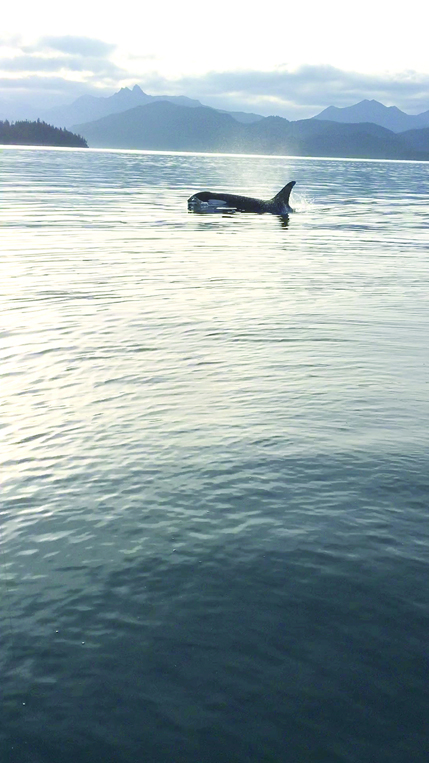If you’ve spent more than 10 minutes out on the end of the Spit any time in the last few weeks, the odds are pretty good that you’ve seen at least one large marine mammal — a tail flipping up as a humpback dives for feed, maybe, or a fountain of water shooting up from a blowhole.
“I have for sure seen humpback whales in October and November, but that’s maybe twice in nine and a half years,” said Debbie Boege-Tobin, a professor of marine mammal biology at Kachemak Bay Campus, in a phone interview Tuesday. “I was out yesterday with some of my students … and we probably saw at least 12 to 15 humpbacks.”
“Last night off the Spit we probably saw seven. Fishing off Hesketh (Island) the other night we probably saw 30,” said Jim House, a local fisherman who owns the Quickwater water taxi.
Not only are there more whales out in the bay than anyone in the scientific or fishing community can remember having seen before, but they’re sticking around longer. By late October in an ordinary year, the humpback whales that populate Kachemak Bay in the summertime have migrated to the warmer waters of Baja, Mexico, or Hawaii, Tobin said.
It’s not just humpbacks. People on the Spit have reported record sightings of killer whales, minkes and other species. Boat captain Dave Lyon posted in the Kachemak Bay Nature Watch Facebook group that he saw a dozen Dall’s porpoises in the bay in late September. The porpoises look like small killer whales and are an uncommon sighting in this area and at this time of year.
The most likely explanation for the phenomenon seems to be an abundance of prey. According to Tobin, KBC and Eye of the Whale Research biologists have recorded high numbers of king salmon, juvenile herring, capelin, sand lance and the Thysanoessa genus of krill. So far, the scientists haven’t been able to get a clear picture of a whale eating, so they can’t confirm the connection, but the college’s depth sounders have documented whales finding a lot more food than usual.
“The whole food chain is just really happening, just all the pieces seem to be in place to keep everybody happy,” said House, who says he’s caught more king salmon this season than usual.
Explanations for the high levels of prey are still up in the air. Tobin suspects it may have to do with the higher water temperature in the bay and an increase in available nutrients.
It’s unclear how long these feeding conditions will last. With winter approaching and hours of sunlight decreasing every day, the phytoplankton that make up the base of the marine food chain will diminish, said Tobin. If food runs out and the whales head south in December or January, she’s worried they’ll encounter dangerous weather conditions that they wouldn’t normally face in an early fall migration.
Most of the whales aren’t equipped to spend the winter in the cold water here, she said. Eye of the Whale Research biologist Olga von Ziegesar has documented humpback whales overwintering in Alaska, but Tobin said those tend to be older females who have already reproduced and in Prince William Sound, not Kachemak Bay.
There’s also concern among local marine biologists that toxins from recent algal blooms will affect the whales. But so far, the increase in whale mortality that scientists have observed in the Gulf of Alaska hasn’t reached Kachemak Bay.
In the meantime, the extra marine visitors and their extended stay have created a whale-watching wonderland.
“You gotta watch for them ’cause they tend to pop up right in front of you and they really don’t care that you’re there,” said House. “No texting and driving in whale territory.”
The abundance of whales has been particularly exciting for students in Tobin’s Semester by the Bay program at the college. All are marine biology students from universities in the Lower 48, here for the semester to get up close and personal with the area’s cetaceans. Tobin said they’re “in heaven.”
“Before coming to Alaska, I had never seen a live whale, only stranded ones on the beaches of North Carolina,” wrote Semester by the Bay student Amelia Johnson in an email. “I am very fortunate to be studying marine biology in an area so rich in productivity and biodiversity as Kachemak Bay. As someone who wants to study large whales as a career, I am in one of the best places on Earth to get hands-on experiences with these magnificent animals.”
Some of the students are even getting involved with the research themselves. A few of them are helping biologist Ginger Moore to revamp a running log of whale sightings and identifications in the area. The site aims to increase biologists’ basis of knowledge about the animals and their habitat and give members of the general public access to the same information.
The researchers plan to launch KBayWhales.com at the end of the semester, and would appreciate whale photos or sighting details from anyone in the community. With any luck, the new database will help them unlock the ecological mysteries of the bay.
For now, Tobin said it’s too soon to know if the increased whale activity this fall is an anomaly or an indicator of big changes in the ecosystem.
“With higher than average water temperatures, this could be something that we see more often in the future,” she said. “I guess only time will tell.”
Annie Rosenthal can be reached at annie.rosenthal@homernews.com.


